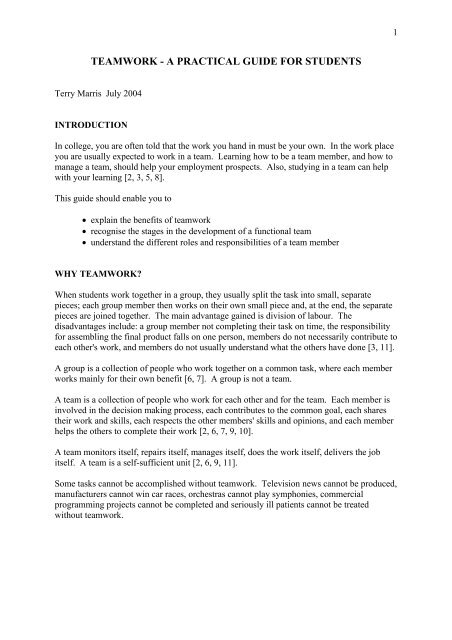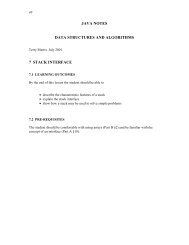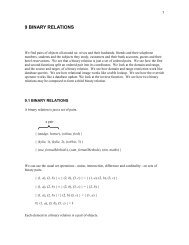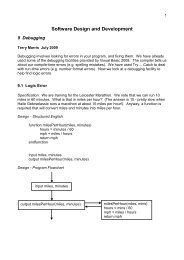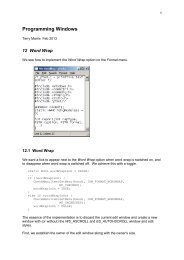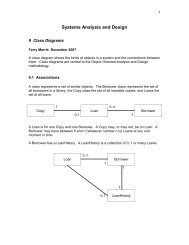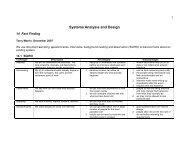TEAMWORK - A PRACTICAL GUIDE FOR STUDENTS - Terry Marris
TEAMWORK - A PRACTICAL GUIDE FOR STUDENTS - Terry Marris
TEAMWORK - A PRACTICAL GUIDE FOR STUDENTS - Terry Marris
You also want an ePaper? Increase the reach of your titles
YUMPU automatically turns print PDFs into web optimized ePapers that Google loves.
1<strong>TEAMWORK</strong> - A <strong>PRACTICAL</strong> <strong>GUIDE</strong> <strong>FOR</strong> <strong>STUDENTS</strong><strong>Terry</strong> <strong>Marris</strong> July 2004INTRODUCTIONIn college, you are often told that the work you hand in must be your own. In the work placeyou are usually expected to work in a team. Learning how to be a team member, and how tomanage a team, should help your employment prospects. Also, studying in a team can helpwith your learning [2, 3, 5, 8].This guide should enable you to• explain the benefits of teamwork• recognise the stages in the development of a functional team• understand the different roles and responsibilities of a team memberWHY <strong>TEAMWORK</strong>?When students work together in a group, they usually split the task into small, separatepieces; each group member then works on their own small piece and, at the end, the separatepieces are joined together. The main advantage gained is division of labour. Thedisadvantages include: a group member not completing their task on time, the responsibilityfor assembling the final product falls on one person, members do not necessarily contribute toeach other's work, and members do not usually understand what the others have done [3, 11].A group is a collection of people who work together on a common task, where each memberworks mainly for their own benefit [6, 7]. A group is not a team.A team is a collection of people who work for each other and for the team. Each member isinvolved in the decision making process, each contributes to the common goal, each sharestheir work and skills, each respects the other members' skills and opinions, and each memberhelps the others to complete their work [2, 6, 7, 9, 10].A team monitors itself, repairs itself, manages itself, does the work itself, delivers the jobitself. A team is a self-sufficient unit [2, 6, 9, 11].Some tasks cannot be accomplished without teamwork. Television news cannot be produced,manufacturers cannot win car races, orchestras cannot play symphonies, commercialprogramming projects cannot be completed and seriously ill patients cannot be treatedwithout teamwork.
2Perhaps the greatest advantage that teamwork brings is the quality of the finished product. Ateam brings together the combined skills, talent and experience of several individuals. Theperformance of a functional team is greater than the sum of its individual members, the teamexperience inspires members to greater achievement and generates ideas that otherwisewould not happen. This is known as the synergistic effect [2, 6]. Teamwork encouragescreativity and the development of new ideas [8].Membership of a functional team improves individual performance. Where each teammember is involved in a team decision, each member is likely to be motivated and committedto producing the best possible result [2]. Quality comes with minimum stress.The team shares decisions and their consequences, success or failure. A member of asuccessful team shares in that success and feels good. Where a team takes the blame for afailure, the blame is shared and the individual feels less bad [2, 8].Teams provide a social framework for working [5] and teamwork develops social skills suchas listening, respecting and helping others [10].Teamwork can provide an excellent learning environment for students [3, 5]. Members canask their team mates the questions they would not ask their lecturer. And because the socialcontact makes teamwork enjoyable students are more likely to stay on the course when theyhave difficulties [3].However, how to make teamwork work is not widely understood or practised [6]. Teamworkdoes not just happen. It is a skill that has to be taught and practised and maintained [8, 9].Like a relationship, you have to keep working at it [2].We are dealing with natural human behaviour here. Loud, dictator like-members want to takeover [10]. Quiet members who feel left out do not co-operate [10]. Resentful memberssuspect that others are not contributing [8]. Strong-minded individuals are reluctant to focuson the team's goals [6]. Self-centred members refuse to put into practice decisions made bythe team. Lazy members and members without commitment switch off and leave the workfor everyone else to do. Disputes and disagreements wreck the team [8, 11].We are dealing with cultural baggage. Our education system is built on competition. We winby doing the work ourselves and getting more marks than anybody else does. If we use thework of others we feel that we are somehow cheating [8]. And certainly, if we use the workof others without acknowledging their contribution, we are accused of plagiarism.We are dealing with project management. We need to set targets. We need to measureprogress made against targets set. We need to schedule events and assign resources. Weneed to maintain documentary evidence of our team work [11]. We need to solve problems.Creating and maintaining a team requires effort. But the effort is amply rewarded with a highquality product and a satisfying experience for the participants.
3<strong>TEAMWORK</strong> IN PRACTICETeamwork is group work plus a lot more.• members work to create a functional team• members accept roles• members hold structured meetings• members keep records of all their work• members use their own and each others skills• differences of opinion are welcomed and used constructively• the finished product is better than from simple group workTeamwork is a process. It involves managing people as well as creating a product [2, 3, 11].The practical guide that follows is based on [11].
4OverviewThis overview enables you to see at a glance the essence of teamwork.TaskSelect team membersEvaluate team functionDecide team rolesKeep recordsHold team meetingsMake decisionsResolve disputesActivity or Function• look for a range of skills• share the same goal• can meet regularly• forming - the team comes together.• storming - working out differences• norming - establishing responsibilities and routines• performing - getting the job done. The team is fully functional.• meeting recorder - writes and publishes the minutes• meeting visualiser - writes discussion points on the whiteboard• analyst - good problem solver• writer - edits reports and documents• facilitator - keeps the team focussed and functional• graphics - produces illustrations, charts and diagrams• leader - shared by all• task tracker - ensures tasks are completed at the right time• archivist - keeps all the team records in order• meeting agenda• meeting minutes• Gantt charts• events diary• citation notes• draft reports• e-mails between members• notes of impromptu discussions• regularly• attended by everybody• start and finish on time• published agenda• published minutes• accompanied by food• everybody's contribution welcomed• categorise as minor or major• use criteria• respect everyone's opinion• no blame• look for compromise and win-win solutions• refer to team objectivesDo not assume that teamwork happens naturally - it does not. Do not assume that someoneelse will do the job - they will not. Do not assume that a stage does not matter - every stageis important.
5Forming a TeamYou should ask these questions because you are trying to form a well-balanced team with agood range of skills. If your team members are chosen for you, you should still ask thequestions because then you can see where your strengths and weakness as a team lie.QuestionDo we havecomplementary skills?Do we have similarinterests?What experience do wehave?How serious are we?Can we meet regularly?Can we easilycommunicate with eachother?CommentThe skills needed to complete a project include• creativity - to generate new ideas• presentation - to organise an oral presentation• analytical - to understand problems• graphical representation - to produce drawings anddiagrams• co-ordinator - to help the team work together• writer - to document the project in accurate English• organiser - to schedule and track a complex process• technical expertise - to complete the project tasksDiscussion should help members make proper choices for thesub-tasks and for team member roles.You are looking for any other experience that might help withaspects of the project.Agree on goals such the grade you are aiming for and thenumber of hours per week you are going to devote to theproject.Twice a week is best, plus once a week with the projectsupervisor.Exchange mobile phone numbers and e-mail addresses. Can aweb page forum be created and used?Do not choose partners just because they are your friends - the important questions youshould ask are not taken seriously. Do not choose partners who have incompatible schedules- you will never see them. Do not chose partners just because they are good looking - itmight help your social life but not your team work. You are looking for a well-balanced teamhere with a wide range of skills.
6Becoming a Functional TeamIdentifying where the team is in the development process helps it to become more efficient,creative and productive, but only if the team is deliberately striving towards being fullyfunctional. These stages in team development come from the work of Bruce Tuckman and MJensen [13].Stage Process ProductForming The team comes together for the first time.Members are getting to know each other, the skillseach brings and what each expects. Everybody isvery polite. Dominant personalities emerge.Answers to the questions set on the previoussection - Forming a Team - are discussed.The team lacks clear direction and wants someoneelse to tell them what to do.StormingNormingPerformingTeam members are trying their ideas out on eachother and there is little agreement.Members feel that their contribution is not valued.Members are more interested in their own ideasthan integrating and using the ideas of others.Members with conciliation skills help minimisethe time spent in this non-productive stage.Team members have learned to trust and respecteach other and are moving on to the work of theproject. People management skills have improved.Members agree their team roles.Members agree their project tasks.Members agree the amount of work each is to do.Spirit of co-operation evident.Members start listening to each other andrespecting each other's opinions.The team is now fully functional. The main focusis on the project.Regular meetings are held. All members attendand come prepared. Meetings are documentedwith agendas and minutes.Team members perform their roles efficiently andslip into each other’s roles effortlessly.Decisions are readily reached and implemented.Members continuously review the team's progress.Views are freely exchanged.Members support and help each other.Members feel free to express their ideas withoutfear of personal criticism.Notes on each teammember, the skills andexperience they bring,and their expectations.Little or no progress ismade on the project task.Notes on different waysof tackling the project -but no agreed aims,objectives and methods ofworking.Aims, objectives andworking methods areagreed and documented.Gantt chart.Events DiaryTeam meeting Agendasand minutes.Results of tasks aredocumented and sharedDrawings, reports andprototypes are createdUpdated Gantt charts andEvents Diary.These stages apply to every team without exception. Remember to involve every member inthe decision process. Do not allow members with the loudest voice to dominate.
7Assigning Teamwork RolesA fundamental principle of teamwork is to share the load. Members work on specific tasksrelated to the project. Members also take on specific roles related to the team. Every role hasto be filled one way or another.RoleMeeting RecorderMeeting VisualiserAnalystWriterFacilitatorGraphicistLeaderTask TrackerArchivistCommunicatorCommentResponsible for writing down what happens in meetings.Records key points especially decisions, responsibilities and due dates.Issues minutes (within 24 hours of the meeting being held if possible).Contributes to the discussion.Writes down important points on the whiteboard. This helps keep thediscussion focussed and often leads to new ideas.Clear handwriting helps.Contributes to the discussion.Someone who is good at solving puzzles.Experience with Excel useful.Someone who is good at writing technical documents and reports.Ability to write clear, accurate English essential.Someone who keeps the team focussed on its goal and who keeps theteam reminded of good team practice. Someone who is good atresolving differences between individuals.Could be shared simultaneously between all the members.Essential for rapid transition from the forming to the performing stagein team development.Someone who is good at representing objects and processes indiagrams.Ability to use graphics and drawing packages useful.Best passed from member to member as required for tasks such asorganising meetings, planning how the project is to be completed,deciding time scales, setting goals, monitoring performance andscheduling reviews.Someone who keeps track of all the deadlines and deliverables, bothinternally and externally.Reminds members when their contribution is needed.Ability to use project management software essential.Someone who files all the group’s documents in a structured, orderlyway.Sectioned lever arch file handy here.Someone who maintains the team's forum page on the web.Ability to set up and maintain the forum essential. Enforces forumetiquette.Each of these roles is essential. Settle on who does what role early on in the project. Eachmember is responsible for taking on unfulfilled roles, as is the team. Remember to writedown responsibilities and due dates.
8Holding MeetingsStructured, documented and worthwhile meetings are essential to the success of any team.ActionEstablish a regular timeEveryone must comeKeep to promised start andfinish timesUse an agendaTake minutesRecognise everyoneMeet over foodCommentAll members can attend if they agree a time that is fixedfrom week to week and if it is given the highest priority byall. A regular time means there can be no excuses.There are no exceptions - except really serious illness orclose family bereavement.Proper minutes provide evidence of who is attending.Members have other commitments also.Agendas give purpose and direction to meetings.Agree on changes to the agenda at the beginning of themeeting.Allocate time for each agenda item and stick to it.Put new items at the end.One person should take minutes so that there is at least arecord of decisions made, responsibilities accepted and dateswhen tasks must be done by.Short minutes organised by topic are best.Identify action items - things that the team has decided mustbe done by whom and by when.Distribute typed up minutes within 24 hours if at allpossible.Record who was present and who was notEvery team has quiet members. Quiet ones often welcomebeing asked and are usually the source of brilliant ideas.Every team has argumentative, loud members. Ask them tosummarise what has been said so far and ask them to get theviews of everybody else.Makes the social aspect of teamwork thoroughly enjoyable.Set up meetings well in advance. Agendas are crucial - write one down at the beginning of ameeting if necessary. Keep proper records to prevent the loss of good ideas and decisions.
9Making DecisionsThe team needs to be skilled at making decisions.SuggestionCategorise decisions intomajor and minorGive adequate timeUse criteriaHear everyone's opinionCommentA major decision makes a significant difference.Decide which are major and which are minor.If there is no agreement, understand why different membersdisagree.Do not spend so much time on minor decisions that there isnot enough time left for major ones.Give advance notice of when decisions are required.Discuss decisions before they have to be made and give timefor members to think about them.Define criteria against which alternatives can be evaluated.Between five and ten criteria is probably best.Use a criteria matrix - a table with columns headedalternatives and rows titled criteria. Each cell has a ratinge.g. 0..5. Sum the scores for each alternative.The quiet members often have good ideas. Members whoseopinions are not sought may find it difficult to support adecision because they do not feel they are part of the teamDo not assume that everyone agrees on a decision. Do not put off making decisions longerthan necessary - minimises pressure towards the end. Consider all the implications of adecision - criteria helps here. Ensure that there is enough time to discuss major onesdecisions.
10Keeping RecordsDocumenting the project and the team activity is essential.Document Purpose Method and FormMeeting agenda An agreement on whatwill be discussed at ameeting and how muchtime each agenda itemwill takeAn agenda in advance of the meeting is best.An agreed agenda discussed at the beginningof a meeting and written on the whiteboard isbetter than nothing.Meeting minutesCitation notesDraft reportProject archiveRecord what happened ata meetingKeep track of all sources- web sites, authors,personal contact, ...A working document thatshows the progresstowards the finaldocumentA record of all importantdocuments for the projectInclude• the date• who was/was not present• decisions made• actions required - by whom and bywhenCirculate the minutes within 24 hours of themeetingUse cards, or simple notes on paper or aWord fileA ring binder or lever arch file updated eachweek by the archivist.At the beginning may only contain a table ofcontents and heading pages for each section.As the project progresses drafts ofsections are included.Reviewed by the project supervisor so thatassurance that the team is on the right trackmight be given.Lever arch file, always available forreference. Include• meeting minutes• research notes• e-mails and written notes betweenmembers• notes from brainstorming andinformal meetings• Gantt Charts - reviewed andupdated weekly.• Events Diary - a diary into thefuture of every event that might (ormight not) affect the team and itsoperations. Updated and reviewedweekly .If no records are kept, then important information, brilliant ideas and good decisions are lost.Keep records as the event happens. Record keeping is an important responsibility. The trickis to write everything down.
11Handling DisputesDisagreements are inevitable when more than one person is working on the same task. Thebest teams use disagreements as a source of inspiration and innovation. The worst teamsdegenerate into personal insults and disaster.ActionStay calmClassify thedisputeLook forcompromiseCommentTempers and voices rise in disputes. Deliberately talk quietly.Listen to what the other person says.Assume the other is well-intentioned.If intellectual consider• explicit statements of facts - distinguish from assumptions• comparison of criteria• consideration of consequences• precedence - what has happened in previous, similar situations• ask one to argue the case from the other's point of viewIf personal (often amount of work done) consider, in addition to above• using another team member to mediate• having a cooling off period• discussing the feelings involved (while the other person listensin silence)If intellectual, the compromise may be better than either point of view.If personality, the compromise should leave each feeling the resolutionwas fair even if neither got what they wanted.Disputes are not resolved by shouting. Appeal to an outside authority only as a very lastresort when all other methods have failed. See the other person's point of view.
12Managing Human BehaviourWhatever the situation, the trick is to focus on the team, its purpose and goals. The team'spurpose and goals should be clearly stated so that they can be referred to. If something is tobe decided, the team decides it. If there is a problem, the team solves it. If a member is notperforming, it is the team who asks "what can we do to help?" (not "what are you going to doabout it?"). Never blame the individual. Failure is a team responsibility.BehaviourThe quiet memberThe loud memberThe forgotten decisionThe ignored decisionThe non-performingmemberNegative criticismSuccessFailureDeadlockFocusCommunicationCommentA valuable resource. The member is responsible for taking partand contributing. The team is responsible for including the quietmember in discussions and decisions.The member is responsible for being aware of their behaviour.The team is responsible for asking the member to summarise whathas been said so far and then asking each team member for theirviews.Decisions that are not recorded have to be discussed again. Theteam is responsible for ensuring that decisions are recorded.The member is responsible for accepting the team's decision evenif he or she does not agree with it. The team is responsible forensuring that the decision is implemented some how or other.The member is responsible for ensuring that the deadlines agreedto are met. The team is responsible for meeting the deadline eventhough a member has missed it.Both the member and the team are responsible for not criticisingthe person but ensuring that criticisms are made in terms of thetask. Every criticism should be accompanied by a suggestion forimprovement.Be enthusiastic in your approval and generous in your praise.Failure is shared by the team and is not the fault of an individual.The team is responsible for learning lessons and turning failuresinto successes. The team asks: "How can we do better?"Each party argues the point from the other party's point of view.Common ground is emphasised.Differences might form a third alternative.Judge alternatives against the task and the team's goals.Set a time limit.If the team decides the problem is not major or critical, toss a cointo decide the issue.When a member wanders from the point, the team gently bringshim or her back to it and the team's goals.Communication is the responsibility of both the speaker and thelistener. Use every means possible including face to face, phonecalls, written notes, e-mails, electronic forum.Deal with unproductive and negative behaviour head on. Begin with praise and honestappreciation. Call attention to mistakes indirectly. Talk about your own mistakes beforecriticising others. Ask questions instead of giving orders. Let others save face. Praise everyimprovement. Make the fault seem easy to put right. Use encouragement. Make othershappy about doing the right thing [4].
13Review and EvaluationEvaluation involves making informed judgements about a product against clear criteria. Itinvolves judging worth, quality and fitness of purpose.Evaluate your team's teamwork against the model of a functional, performing team. Youneed to establish the criteria for a successful, fully-functioning team then measure how yourteam stands up to the criteria identified. You could start by completing a table something likethe one shown below.Criteria (for a functionalteam)Students listen to each othersideas and build on them.Product (your team's actualbehaviour)Judgement (yourconclusions)Students interact with eachother, discussing and puttingquestions to all members ofthe team.Students exchange, defendand re-think ideas.Students respect the opinionsof others. Students encourageand support each other.Students help each other.They ask "How can I help?"Students share their work,findings and ideas with eachother.Each student contributes.Evaluate your own performance against the role(s) you adopted and your contributions to theteam.What lessons have been learned? Be specific. How successful was the team in a) completingthe project and b) working as a team? State the evidence. What were the team's strengthsand weaknesses? Did teamwork help the team to achieve the task? Did teamwork help withyour studies?
14Scheduling TasksComplete all these tasks and have a productive experience.Task When Why Who Product CommentSkills,experienceand interestsFirstmeetingVisualiser,recorderIdeageneration /brainstormingSupervisormeetingTeammeetingsManytimesWeeklyOftenKnow the teamand the resourceseach memberbrings.Generate ideas tohelp move theproject alongBring your projectsupervisor up todate on what youare doing, seekadvice ifnecessary.Co-ordinate yourwork, generateideas, keep trackof deadlines andprogress madetowards them,edit documents,enjoy food andcamaraderieVisualiser,recorderVisualiser,recorder,archivist,task trackerVisualiser,recorder,archivist,task trackerLists - on theboard and inyour heads ofwhat youcollectivelybring to theprojectList of ideasto beevaluatedagainst clearcriteriaMeetingminutesTaskassignments.Decisions.Ideas.MinutesCombine with adiscussion ofwhat you hopeto get out of theproject andnon-academicinterestsWorkindividually atfirst, then cometogether for ageneraldiscussion.Never criticiseideas.Requirespreparationprior to themeeting. Bringquestions andorganiseddocuments toshow what hasbeen achievedand thedirection theteam is taking.Schedule theseand stick to anagenda.
15CONCLUSIONThis guide• explained the benefits of teamwork - enhanced quality of finished product• described the stages in the development of a functional team - forming, storming,norming and performing• explained the processes of effective teamwork - communication between memberscompleting a shared task, focus on common goals, solving problems, training,practice and evaluation• described the different roles of a team member - recorder, visualiser, analyst,writer, facilitator (co-ordinator) graphics artist, leader, task tracker, archivist andcommunicator• described the responsibilities of a team member - involvement, commitment,respect, enthusiasm, adaptability, backup and support. There is no I in teamwork.
16BIBLIOGRAPHY[1] AVERY C.M. The Eight Most Common Myths About Teamworkhttp://www.businessknowhow.com/manage/mythteam.htmAccessed July 2004[2] BLAIR G.M. Groups that Workhttp://www.see.ed.ac.uk/~gerard/management/art0.htmlAccessed July 2004[3] BLAIR G.M. Laying the Foundations for Effective Teamworkhttp://www.see.ed.ac.uk/~gerard/teaching/art0.htmlAccessed July 2004[4] CARNEGIE D. How to Win Friends and Influence People Cedar Books 1938[5] DOBBIE G. Supporting Teamwork in a Computer Science Coursehttp://www.cdtl.nus.edu.sg/link/mar2001/team1.htmAccessed July 2004[6] LENCIONI P.M. The Trouble with Teamwork Leader to Leader Institute Summer2003 pp 35..40http://www.pfdf.org/leaderbooks/121/summer2003/lencioni.htmlAccessed July 2004[7] SAMAR E. Teamwork and Team Building: How to Work as a Teamhttp://ky.essortment.com/teamworkandt_rhuw.htmAccessed July 2004[8] WILSON D. Teamwork http://www.firelily.com/opinions/teamwork.htmlAccessed July 2004[9] Making the Team Work NewsLab Report Vol 4 No 3 Fall 2000http://www.newslab.org/newsletter/newslabfall02.pdf Accessed July 2004[10] Bellingham Schools 7 Essential Skills for Teamworkhttp://www.bham.wednet.edu/studentgal/onlineresearch/oldonline/mod8team.htmAccessed July 2004[11] Teamwork - A Practical Guide for Studentshttp://files.irt.drexel.edu/courseweb/Mitchell_Courses/TeamworkAccessed July 2004[12] Teamwork Quotes and Proverbs http://heartquotes.net/teamwork-quotes.htmlAccessed July 2004[13] TUCKMANN B.W. and JENSEN M.A.C. Development Sequences in Small GroupsPsychological Bulletin Vol LXIII no 6 1965 (cited in [3] and [11]).


